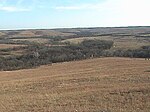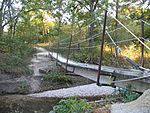Konza Prairie Biological Station
| Konza Prairie | |
|---|---|
 Konza in spring with herd of bison in distance | |
 USGS topographic map of Konza Prairie | |
| Location | 10 km (6.2 mi.) south of Manhattan, Kansas, Geary County, Flint Hills, Kansas, United States |
| Coordinates | 39°05′35″N 96°33′31″W / 39.09306°N 96.55861°WCoordinates: 39°05′35″N 96°33′31″W / 39.09306°N 96.55861°W |
| Area | 34.9 km2 (13.5 sq mi) |
| Elevation | 330 m (1,080 ft) |
| Established | 1971 |
| Operator | The Nature Conservancy, Kansas State University |
| Website | Konza Prairie Biological Station |
The Konza Prairie Biological Station is a 3,487-hectare (8,616 acre, 13.5 sq mi) preserve of native tallgrass prairie in the Flint Hills of northeastern Kansas. It is located south of Manhattan, Kansas and its southern boundary parallels Interstate 70. A scenic overlook exists on the preserve's eastern boundary along K-177. "Konza" is an alternative name for the Kansa or Kaw Indians who inhabited this area until the mid-19th century. [1]
The Konza Prairie is owned by The Nature Conservancy and Kansas State University, and is operated as a field research station by the university's Division of Biology. It is one of 26 sites within the Long Term Ecological Research Network. The Konza prairie was designated a UNESCO biosphere reserve in 1978. It was one of 17 reserves in the United States withdrawn from the programme in June 2017 by request of the U.S. government.[2][3]
It has a continental climate characterized by warm, wet summers and dry, cold winters. Average annual precipitation (32.9 in, 835 mm) is sufficient to support woodland or savanna vegetation; consequently, drought, fire and grazing are important in maintaining this grassland. The site is topographically complex with an elevation range from 1050 to 1457 ft (320 to 444 m).[4] In addition to the dominant tallgrass prairie, Konza contains forest, claypan, shrub and riparian communities. Limestone outcrops are found throughout the landscape.
Konza Prairie is located within the largest remaining area of unplowed tallgrass prairie in North America, the Flint Hills. Konza supports a diverse mix of species including 576 vascular plants,[5] 31 mammals,[6] 208 bird species,[7] 34 types of reptiles and amphibians, 20 kinds of fish, and over 700 types of invertebrates. A herd of approximately 300 bison[8] is maintained on the Konza, and native white-tailed deer and wild turkey are often present in large numbers.[9]
Members of the public are allowed onto portions of the Konza Prairie through three loop hiking trails (approximately 2.6, 4.5, and 6 miles).

The Konza in winter.

A Konza walking trail in the fall.

This bridge crosses Kings Creek.
See also[]
References[]
- ^ "Konza Prairie Biological Station," http://kpbs.konza.k-state.edu/history/, accessed 1 Nov 2017
- ^ UNESCO. "Biosphere Reserves: Konza Prairie". Retrieved 6 September 2018.
- ^ "23 new sites added to UNESCO's World Network of Biosphere Reserves". 14 June 2017. Retrieved 6 September 2018.
- ^ "Konza Prairie Site Description".
- ^ Listing of the known Konza Prairie vascular plants alphabetized by common name.
- ^ NPWRC :: Checklists of the United States
- ^ "The Birds of Konza". Archived from the original on 2007-06-09. Retrieved 2007-08-05.
- ^ "Archived copy". Archived from the original on 2008-12-03. Retrieved 2008-08-16.CS1 maint: archived copy as title (link)
- ^ "Prairie Research Could Help Farming Become More Resilient, Sustainable". Pulitzer Center. Retrieved 2021-03-01.
External links[]
- Konza Prairie Partnership
- Long Term Ecological Research (LTER) Program
- Konza Environmental Education Program
- Konza Prairie photos on Flickr
- UNESCO Biosphere Reserve Information
| Wikimedia Commons has media related to Konza Prairie in Manhattan, Kansas. |
- Grasslands of the North American Great Plains
- Temperate grasslands, savannas, and shrublands in the United States
- Flora of the United States
- Protected areas of Geary County, Kansas
- Protected areas of Riley County, Kansas
- Grasslands of Kansas
- Nature reserves in Kansas
- Prairies
- Biosphere reserves of the United States
- Biological stations



